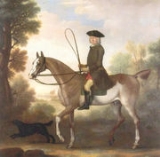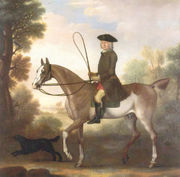
James Seymour
Encyclopedia
James Seymour was an English
painter, widely recognized for his equestrian
art
.
 Seymour was born in London
Seymour was born in London
. His father was an amateur artist and art dealer, whose other business dealings (as a banker, goldsmith, and diamond merchant) afforded young Seymour the leisure time to study art on his own, either his father's or the art at the Virtuosi Club of St. Luke - a gentleman's club his father belonged to, specializing in art. In a short time the boy was a self-taught artist, familiar with many of the prominent artists of the period.
Seymour's love of art was matched only by his love of horse
s. He began spending time at racetracks
early on, and before long found himself absorbed in the sport - drawing, painting, owning, breeding, and racing horses. His art proved popular among the prominent sporting families of the day, eventually garnering Seymour patrons in Sir William Jolliffe and Charles Seymour, 6th Duke of Somerset
. Jolliffe's love for horses and art proved great, and his will would later establish an equestrian statue in Hampshire
. In time, Seymour's work and fame had spread throughout Europe
and America
.
Though ultimately his love for horseracing
led to his financial ruin, Seymour still ranks among the most important early sporting artists, together with John Wootton
and Peter Tillemans
being considered one of the three founders of the sporting school.
England
England is a country that is part of the United Kingdom. It shares land borders with Scotland to the north and Wales to the west; the Irish Sea is to the north west, the Celtic Sea to the south west, with the North Sea to the east and the English Channel to the south separating it from continental...
painter, widely recognized for his equestrian
Equestrianism
Equestrianism more often known as riding, horseback riding or horse riding refers to the skill of riding, driving, or vaulting with horses...
art
Art
Art is the product or process of deliberately arranging items in a way that influences and affects one or more of the senses, emotions, and intellect....
.

London
London is the capital city of :England and the :United Kingdom, the largest metropolitan area in the United Kingdom, and the largest urban zone in the European Union by most measures. Located on the River Thames, London has been a major settlement for two millennia, its history going back to its...
. His father was an amateur artist and art dealer, whose other business dealings (as a banker, goldsmith, and diamond merchant) afforded young Seymour the leisure time to study art on his own, either his father's or the art at the Virtuosi Club of St. Luke - a gentleman's club his father belonged to, specializing in art. In a short time the boy was a self-taught artist, familiar with many of the prominent artists of the period.
Seymour's love of art was matched only by his love of horse
Horse
The horse is one of two extant subspecies of Equus ferus, or the wild horse. It is a single-hooved mammal belonging to the taxonomic family Equidae. The horse has evolved over the past 45 to 55 million years from a small multi-toed creature into the large, single-toed animal of today...
s. He began spending time at racetracks
Race track
A race track is a purpose-built facility for racing of animals , automobiles, motorcycles or athletes. A race track may also feature grandstands or concourses. Some motorsport tracks are called speedways.A racetrack is a permanent facility or building...
early on, and before long found himself absorbed in the sport - drawing, painting, owning, breeding, and racing horses. His art proved popular among the prominent sporting families of the day, eventually garnering Seymour patrons in Sir William Jolliffe and Charles Seymour, 6th Duke of Somerset
Charles Seymour, 6th Duke of Somerset
Charles Seymour, 6th Duke of Somerset , sometimes referred to as the "Proud Duke". The son of Charles Seymour, 2nd Baron Seymour of Trowbridge, and Elizabeth Alington , he succeeded his brother Francis Seymour, 5th Duke of Somerset, to the dukedom when the latter was shot in 1678...
. Jolliffe's love for horses and art proved great, and his will would later establish an equestrian statue in Hampshire
Hampshire
Hampshire is a county on the southern coast of England in the United Kingdom. The county town of Hampshire is Winchester, a historic cathedral city that was once the capital of England. Hampshire is notable for housing the original birthplaces of the Royal Navy, British Army, and Royal Air Force...
. In time, Seymour's work and fame had spread throughout Europe
Europe
Europe is, by convention, one of the world's seven continents. Comprising the westernmost peninsula of Eurasia, Europe is generally 'divided' from Asia to its east by the watershed divides of the Ural and Caucasus Mountains, the Ural River, the Caspian and Black Seas, and the waterways connecting...
and America
Americas
The Americas, or America , are lands in the Western hemisphere, also known as the New World. In English, the plural form the Americas is often used to refer to the landmasses of North America and South America with their associated islands and regions, while the singular form America is primarily...
.
Though ultimately his love for horseracing
Horse racing
Horse racing is an equestrian sport that has a long history. Archaeological records indicate that horse racing occurred in ancient Babylon, Syria, and Egypt. Both chariot and mounted horse racing were events in the ancient Greek Olympics by 648 BC...
led to his financial ruin, Seymour still ranks among the most important early sporting artists, together with John Wootton
John Wootton
John Wootton was an English painter of sporting subjects, battle scenes and landscapes, and illustrator.-Life:Born in Snitterfield, Warwickshire , he is best remembered as a pioneer in the painting of sporting subjects – together with Peter Tillemans and James Seymour – and was considered the...
and Peter Tillemans
Peter Tillemans
Peter Tillemans was a Flemish painter, best known for his works on sporting and topographical subjects. Alongside John Wootton and James Seymour, he was one of the founders of the English school of sporting painting....
being considered one of the three founders of the sporting school.
External links
- http://www.artcyclopedia.com/artists/seymour_james.html
- http://www.fitzmuseum.cam.ac.uk/opac/search/cataloguesummary.html?_searchstring_=(maker='Seymour,%20James')&_limit_=50&_function_=xslt&_resultstylesheet_=imagecs

